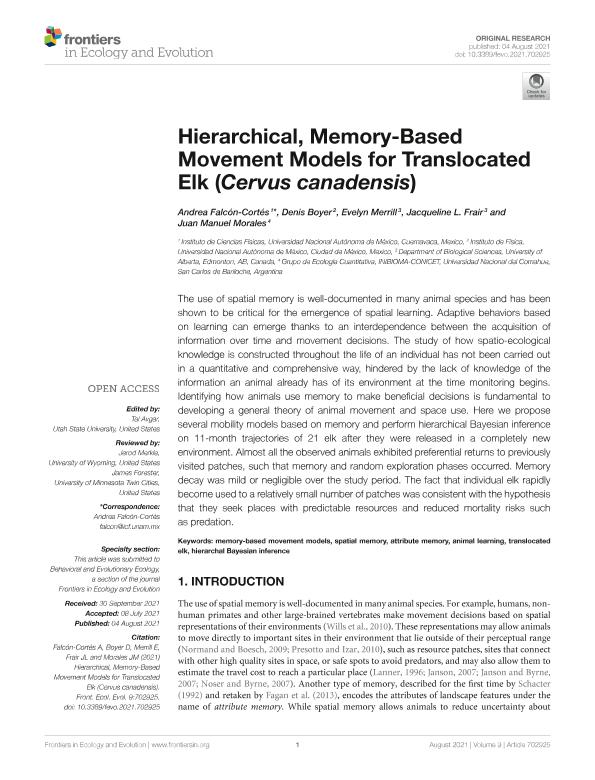Mostrar el registro sencillo del ítem
dc.contributor.author
Falcón Cortés, Andrea
dc.contributor.author
Boyer, Denis
dc.contributor.author
Merrill, Evelyn
dc.contributor.author
Frair, Jacqueline L.
dc.contributor.author
Morales, Juan Manuel

dc.date.available
2023-09-19T17:26:46Z
dc.date.issued
2021-08
dc.identifier.citation
Falcón Cortés, Andrea; Boyer, Denis; Merrill, Evelyn; Frair, Jacqueline L.; Morales, Juan Manuel; Hierarchical, Memory-Based Movement Models for Translocated Elk (Cervus canadensis); Frontiers Media; Frontiers in Ecology and Evolution; 9; 702925; 8-2021; 1-13
dc.identifier.uri
http://hdl.handle.net/11336/212124
dc.description.abstract
The use of spatial memory is well-documented in many animal species and has been shown to be critical for the emergence of spatial learning. Adaptive behaviors based on learning can emerge thanks to an interdependence between the acquisition of information over time and movement decisions. The study of how spatio-ecological knowledge is constructed throughout the life of an individual has not been carried out in a quantitative and comprehensive way, hindered by the lack of knowledge of the information an animal already has of its environment at the time monitoring begins. Identifying how animals use memory to make beneficial decisions is fundamental to developing a general theory of animal movement and space use. Here we propose several mobility models based on memory and perform hierarchical Bayesian inference on 11-month trajectories of 21 elk after they were released in a completely new environment. Almost all the observed animals exhibited preferential returns to previously visited patches, such that memory and random exploration phases occurred. Memory decay was mild or negligible over the study period. The fact that individual elk rapidly become used to a relatively small number of patches was consistent with the hypothesis that they seek places with predictable resources and reduced mortality risks such as predation.
dc.format
application/pdf
dc.language.iso
eng
dc.publisher
Frontiers Media

dc.rights
info:eu-repo/semantics/openAccess
dc.rights.uri
https://creativecommons.org/licenses/by/2.5/ar/
dc.subject
ANIMAL LEARNING
dc.subject
ATTRIBUTE MEMORY
dc.subject
HIERARCHAL BAYESIAN INFERENCE
dc.subject
MEMORY-BASED MOVEMENT MODELS
dc.subject
SPATIAL MEMORY
dc.subject
TRANSLOCATED ELK
dc.subject.classification
Ecología

dc.subject.classification
Ciencias Biológicas

dc.subject.classification
CIENCIAS NATURALES Y EXACTAS

dc.title
Hierarchical, Memory-Based Movement Models for Translocated Elk (Cervus canadensis)
dc.type
info:eu-repo/semantics/article
dc.type
info:ar-repo/semantics/artículo
dc.type
info:eu-repo/semantics/publishedVersion
dc.date.updated
2023-09-18T13:29:22Z
dc.identifier.eissn
2296-701X
dc.journal.volume
9
dc.journal.number
702925
dc.journal.pagination
1-13
dc.journal.pais
Suiza

dc.journal.ciudad
Lausana
dc.description.fil
Fil: Falcón Cortés, Andrea. Universidad Nacional Autónoma de México; México
dc.description.fil
Fil: Boyer, Denis. Universidad Nacional Autónoma de México; México
dc.description.fil
Fil: Merrill, Evelyn. University of Alberta; Canadá
dc.description.fil
Fil: Frair, Jacqueline L.. University of Alberta; Canadá
dc.description.fil
Fil: Morales, Juan Manuel. Universidad Nacional del Comahue. Centro Regional Universitario Bariloche; Argentina. Consejo Nacional de Investigaciones Científicas y Técnicas. Centro Científico Tecnológico Conicet - Patagonia Norte. Instituto de Investigaciones en Biodiversidad y Medioambiente. Universidad Nacional del Comahue. Centro Regional Universidad Bariloche. Instituto de Investigaciones en Biodiversidad y Medioambiente; Argentina
dc.journal.title
Frontiers in Ecology and Evolution
dc.relation.alternativeid
info:eu-repo/semantics/altIdentifier/doi/http://dx.doi.org/10.3389/fevo.2021.702925
dc.relation.alternativeid
info:eu-repo/semantics/altIdentifier/url/https://www.frontiersin.org/articles/10.3389/fevo.2021.702925/full
Archivos asociados
